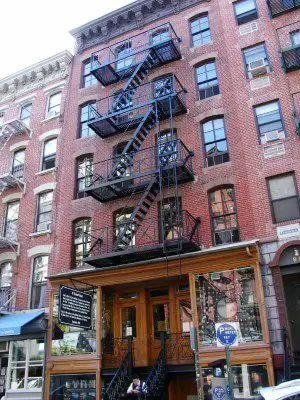 Although the Statue of Liberty is compelling symbolism (and easy to enjoy for free by riding the Staten Island Ferry) the more thrilling story of the American dream is best found in two other places in New York City: the Immigration Museum at Ellis Island and a little nondescript building at 97 Orchard Street on the busy Lower East Side….
Although the Statue of Liberty is compelling symbolism (and easy to enjoy for free by riding the Staten Island Ferry) the more thrilling story of the American dream is best found in two other places in New York City: the Immigration Museum at Ellis Island and a little nondescript building at 97 Orchard Street on the busy Lower East Side….
On a recent trip to New York for Condé Nast Traveler, I took the subway down to the Delancey Street station and walked over a couple of blocks to Orchard. The museum shop at 108 Orchard is across the street from the actual restored tenement, and that’s where visitors can get tickets and gather with their tour group (yes, there’s a bathroom – always a key bit of data for travelers!)
The museum is open by guided tour only; there are often school groups going through on weekdays, and weekends are of course crowded, so reserve tickets in advance online when possible.
There are several different tours (none cover the entire building) that each highlight the stories of real families, almost 7000 people total, who occupied the tenement from when it was built in 1863 to when it was condemned as a multi-family unit in the mid-1930s.
I joined the one called “Piecing it Together,” about the lives of garment workers who lived in the building, including the Rogarshevsky family — we saw the apartment that they lived in, restored to what it might have looked like in their 1918 era. The guide did an excellent job of explaining how the garment-making industry came to dominate the Lower East Side and New York City in general, and how its production methods and workforce changed over the years, but he always smoothly brought the story back to the history of the people in this one building.
He also pointed out that while the residents of 97 Orchard Street made clothing for just a few cents each, the upscale jeans maker Earnest Sewn is located a half a block up at 90 Orchard and sells jeans for $200 each, many still made in New York.
I was also struck by the story of how the building came to be a museum. From the Web site:
“A historian and social activist, Ruth Abram wanted to build a museum that honored America’s immigrants. New York’s tenements were the perfect place for her museum: these humble, multiple family buildings were the first American homes for thousands of immigrants….97 Orchard’s initial appeal was an available storefront: [museum co-founder Anita] Jacobsen and Abram considered renting the space to run tours of the Lower East Side.
While inspecting the storefront, Jacobsen went to the hallway to look for a bathroom. She saw sheet-metal ceilings, turn-of-the-century toilets and an aging wood banister. “It was as though people had just picked up and left”, Jacobson recalled. “It was a little time capsule…I called Ruth and said ‘We have got to have this building.’ It was perfect.”
That was in 1988. Part of the tour today shows visitors photos of how the tenement looked before restoration, and discusses how the rooms had to have decades of wallpaper and linoleum peeled back to see what the rooms used to look like. Rooms that would represent the late 1880s had to have any indoor plumbing removed, of course (the privvies, or toilets, that used to be in the tiny back yard are no longer there.)
The Museum keep ties to today’s immigrant stories by extensive outreach to schoolchildren (many the kids of today’s newly-arrived) and by teaching English as a Second Language classes that tie back to the history of the building and the people within.
I highly recommend a visit to this lively, engaged institution with its enthusiastic and knowledgeable tourguides and living history volunteers. It truly brings the story of the “huddled masses” alive.
Related posts:
- Good eats on New York’s Lower East Side
- New York subway art – Delancey Street mosaics
- For a budget meal in New York, try some ‘wichcraft
- NYC sanctuary: the Public Library
(Update April 2009: The museum has a blog, they’re on Facebook and Flickr, and you can follow its activities on Twitter as well.)

We visited the tenement museum by chance on a visit to New York, and I was so moved by it — it remains one of my favorite “NYC tourist experiences” and I also recommend it to all my friends heading to the city. Thanks for the great post.
Thanks Shelly; it’s a special place, isn’t it?